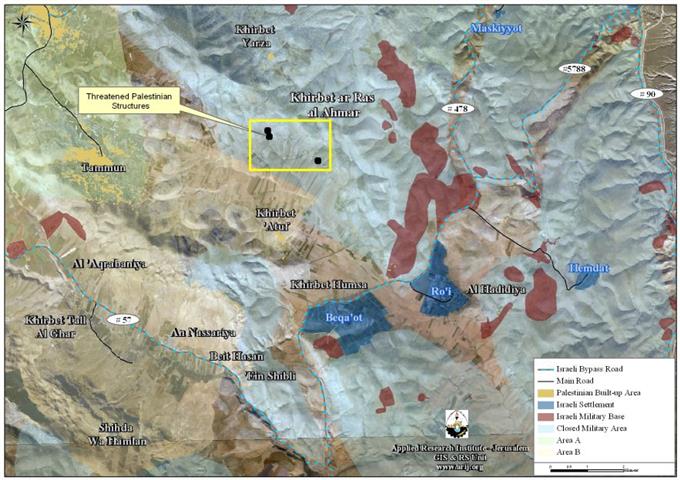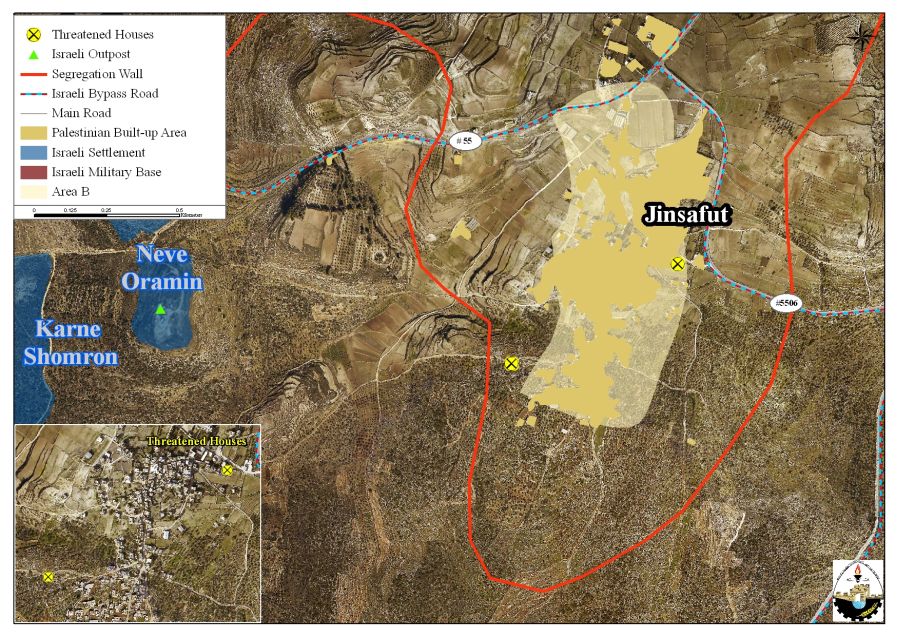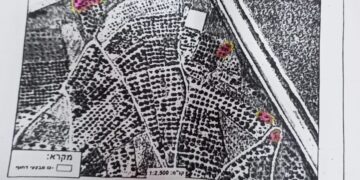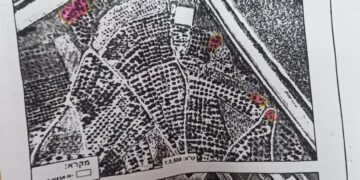|
Table 1: The Threatened structures in Al- Hadidieyh & Khirbet Humsa
|
|||
|
No.
|
Owner
|
Location
|
Structure Description
|
|
1
|
Abdel- Rahim Hussein Bisharat
|
Al- Hadidieyh
|
Residential Barracks
|
|
2
|
Mohammad ‘Ali Bani ‘Odeh
|
Al- Hadidieyh
|
Residential Barracks
|
|
3
|
‘Abdel-Mahdi Riyyad Salamin
|
Al- Hadidieyh
|
Residential Barracks
|
|
4
|
Harb Suleiman Abu Al-Qbash
|
Khirbet Humsa
|
Residential Barracks
|
|
5
|
Isma’il Freikh Abu Al-Qbash
|
Khirbet Humsa
|
Residential Barracks
|
|
6
|
Ibrahim Issa Abu-Al-Qbash
|
Khirbet Humsa
|
Residential Barracks
|

|
Table 2: The Illegal Israeli Settlements located in the vicinity of Al Hadidieyh & Khirbet Humsa In Tubas Governorate
|
||||
|
Colony Name
|
Location
|
Date Establishment
|
Population
|
Area-Dunums
|
|
Mehola
|
Tubas
|
1968
|
362
|
1759
|
|
Beqa’ot
|
Tubas
|
1972
|
156
|
2284
|
|
Ro’i
|
Tubas
|
1976
|
117
|
1573
|
|
Shadmot Mehola
|
Tubas
|
1978
|
516
|
1291
|
|
Hemdat
|
Tubas
|
1980
|
140
|
317
|
|
Rotem (Nahal)
|
Tubas
|
1984
|
18
|
51
|
|
Masskeyyott
|
Tubas
|
1987
|
NA
|
47
|
|
TOTAL
|
*****
|
*****
|
1309
|
7322
|
|
Source : ARIJ Database 2010
|
||||
|
Table3: Details of the threatened houses in Jinsafut village east of Qalqilya
|
||
|
No.
|
Owner
|
Description of the threatened Structure
|
|
1
|
Yahiya Nabhan
|
House
|
|
2
|
Abdel Fattah Rashid Bashir
|
Under construction house
|
|
3
|
Hammad Saleh ‘Id
|
Under construction house
|
|
4
|
Basil ‘Ayed Sabra
|
Timber Warehouse
|
|
5
|
Mohammad ‘Ayed Sabra
|
Barracks
|
|
6
|
‘Atiyya Rayyan
|
Stone Factory
|
|
Source: Jinsafut Village Council
|
||
|
Table 4 : The Illegal Israeli Settlements built on Jinsafut village Lands
|
|||
|
Colony Name
|
Area- Dunums
|
Date Est.
|
Population
|
|
Neve Oranim
|
485
|
1991
|
NA
|
|
Immanuel
|
22
|
1981
|
3199
|
|
Karni Shomron
|
242
|
1978
|
6733
|
|
Total
|
749
|
*****
|
9932
|
|
Source : The Geographical Information System (GIS Unit)- ARIJ 2010
|
|||
| Table 5: Classification of Jinsafut Lands According to Oslo II Interim Agreement of 1995 | ||
| %from the total Town lands | Area-Dunums | Land Classification |
| 0 | 0 | Area A |
| 4 | 377 | Area B |
| 96 | 8,958 | Area C |
| 100 | 9,335 | Total |
| Source: The Geographical Information System (GIS Unit)- ARIJ 2010 | ||
-
Article 53 of the Convention provides that: Any destruction by the Occupying Power of real or personal property belonging individually or collectively to private persons, or to the State, or to other public authorities, or to social or cooperative organizations, is prohibited, except where such destruction is rendered absolutely necessary by military operations.
-
Article 147 of the same Convention indicated that: Extensive destruction and appropriation of property not justified by military necessity and carried out unlawfully and wantonly, is a grave breach of the Convention.
-
Art. 23 of the Hague Convention of 1907 also provide: In addition to the prohibitions provided by special Conventions, it is especially forbidden to destroy or seize the enemy’s property, unless such destruction or seizure be imperatively demanded by the necessities of war;
-
Also Article XXXI, Oslo II, 1995 provides: Neither side shall take any step that will change the status of the West Bank and the Gaza Strip.
Prepared by
The Applied Research Institute – Jerusalem














